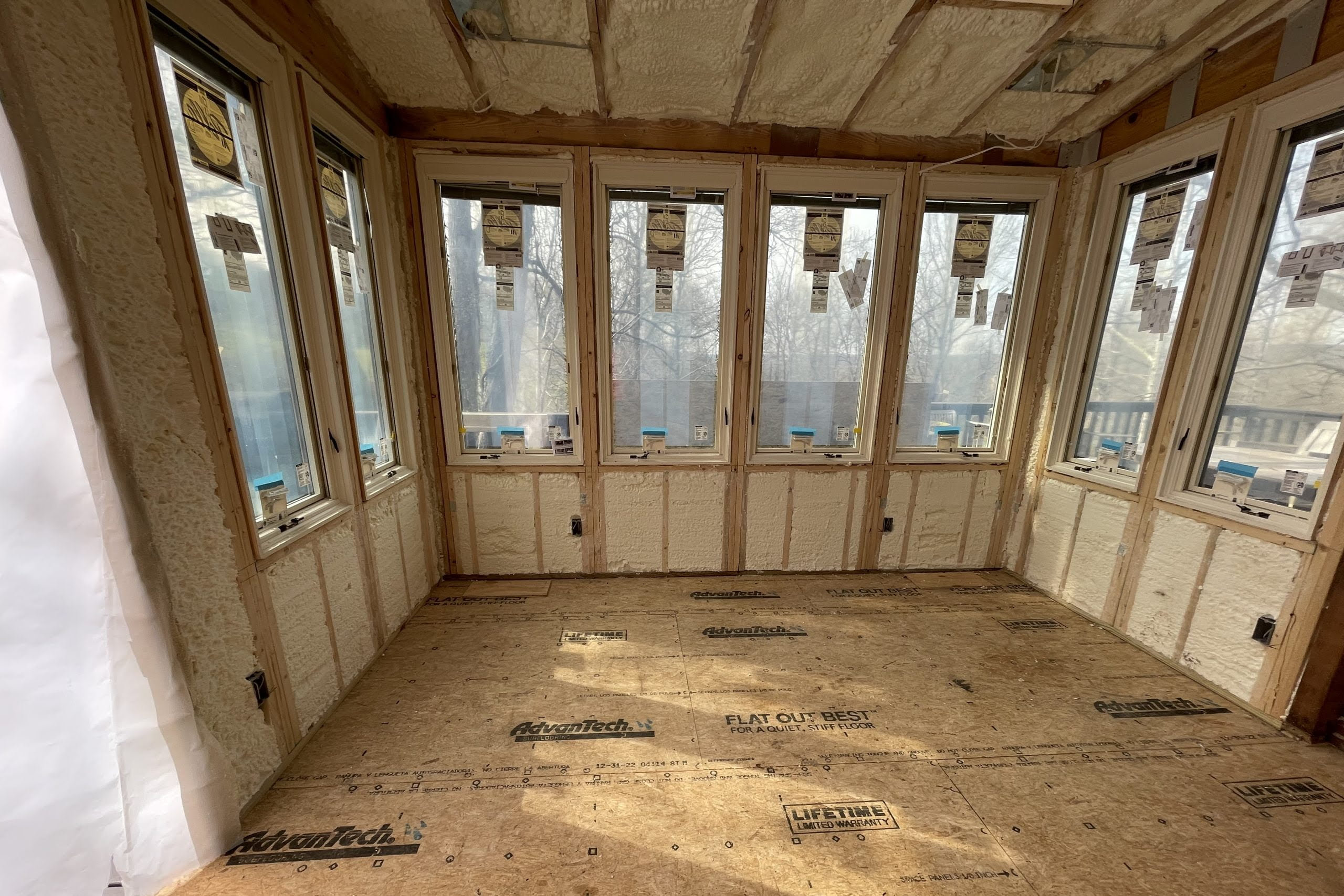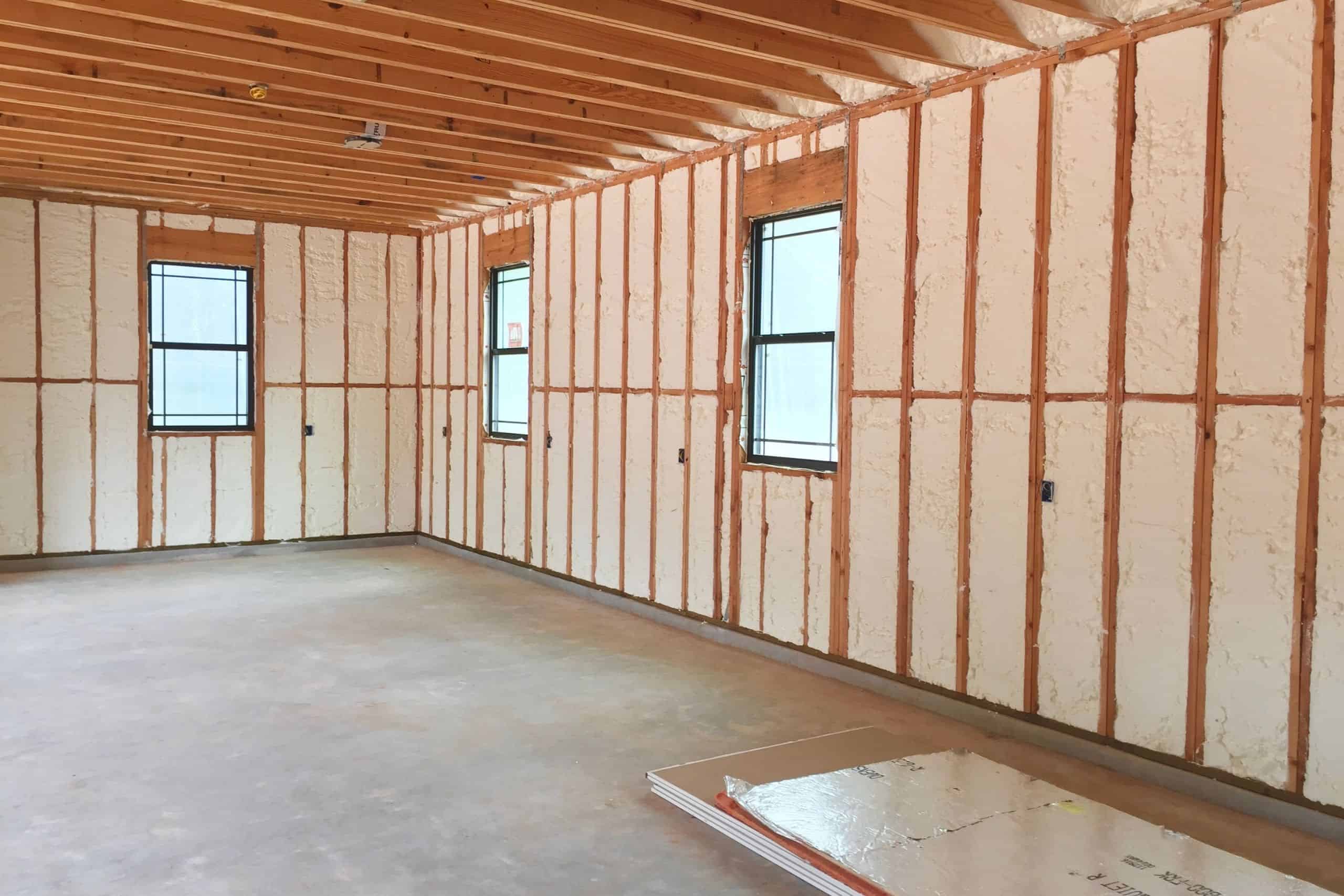Spray foam insulation has risen in popularity in recent years as homeowners and builders recognize the many advantages it provides. This unique insulation method delivers higher energy efficiency, improved comfort, enhanced durability, and other benefits compared to traditional fiberglass batt or blown-in insulation.
Understanding the key benefits spray foam brings to a home, office, or other building can help you decide if it’s the right insulation choice for your next project.
The Significant Energy Savings with Spray Foam Insulation
One of the biggest perks of spray foam insulation is significant energy savings for your home. With its dependable insulating capabilities, it can dramatically reduce your heating and cooling costs.
How Spray Foam Insulation Reduces Energy Consumption
Spray foam insulation achieves better energy efficiency in two key ways:
- Higher R-value per inch: Spray foam has an R-value of around R-6 to R-7.4 per inch. This exceeds fiberglass batt insulation which offers only R-3 to R-4 per inch. The higher R-value means better insulation performance in a smaller space.
- Air sealing ability: Spray foam insulation expands and seals cracks, gaps, and spaces that allow air to escape. This air sealing limits costly leaks that fiberglass insulations miss.
By providing both high insulating power and thorough air sealing, spray foam insulation can stop significant wasted energy in a home.
Using Spray Foam Insulation for Optimal Home Energy Efficiency
To maximize energy savings, spray foam insulation should be applied in key areas:
- Attics: Covering attic floors or roof decks with spray foam ensures efficient insulation of this notoriously leaky area.
- Walls: Filling wall cavities with a full layer of spray foam insulation provides superior thermal protection compared to just fiberglass batts.
- Ducts: Applying spray foam around HVAC ductwork prevents losses from air leaks.
- Crawl spaces: Insulating crawl spaces with spray foam reduces the transfer of heat or cold from the ground.
Prioritizing these common problem areas provides the best performance boost for your energy dollars.
Calculating the Cost Savings with Spray Foam Insulation
The energy efficiency gains with spray foam insulation directly translate into lower utility bills. While upfront costs are higher than other insulations, most homeowners see a complete payback on their investment in 5 to 10 years.
Exactly how much you can save depends on factors like your climate zone, house size, and current insulation levels.
For example, insulating an older 1,800 sq ft home in the Midwest could cut annual heating and cooling costs by 20% or more. At average energy prices, that equates to over $400 in savings per year. Over a decade, total savings from spray foam insulation could add up to $5,000 or more after paying back the upfront cost. Ongoing savings continue to provide value for the lifetime of your home.
The Enhanced Comfort and Air Quality with Spray Foam Insulation
Beyond cost savings, spray foam insulation also enhances comfort and indoor air quality – providing health benefits and greater home enjoyment.
The Role of Spray Foam Insulation in Regulating Indoor Temperature
Spray foam insulation excels at preventing temperature fluctuations in a home. With its continual blanket of insulation coverage, it helps interiors maintain more consistent temps.
Rooms stay warmer in the winter and cooler in the summer with less need to frequently adjust the thermostat. No more hot or cold spots in certain areas or on upper levels. This leads to greater comfort along with lower energy demand from heating or cooling just parts of the home.
Spray Foam Insulation’s Impact on Indoor Air Quality
The air sealing qualities of spray foam also lead to improved indoor air quality. Reducing air leakage curtails the entry of pollutants, allergens, and moisture into the home. Less dust and pollen infiltration provides relief for allergy sufferers. Excess moisture is also controlled to limit mold growth. Many types of spray foam are mold and mildew-resistant as well.
How Spray Foam Insulation Reduces Allergens and Noise
When installed correctly, spray foam insulation acts as a barrier to both allergens and exterior noise entering through walls, ceilings, and floors.
The tight air seal leaves minimal gaps for pollen or dust to seep through. Sound waves also have difficulty passing through the foam insulation barrier.
With spray foam improving indoor air and reducing noise, your home simply becomes a more pleasant and healthy space.
The Long-Term Durability and Sustainability of Spray Foam Insulation
Unlike some other insulation types, spray foam insulation is built to last and provide reliable thermal protection for decades after installation.
The Lifespan and Maintenance of Spray Foam Insulation
When properly applied, spray foam insulation lasts for the life of the building without significant breakdown or sinking. The rigid foam holds its form over time.
No maintenance is required either. Once installed and cured, spray foam requires no upkeep or repairs. This long-term durability ensures optimal insulation performance year after year. Any investment in spray foam pays dividends for 30 years or more.
Spray Foam Insulation as a Sustainable Insulation Option
The longevity and efficiency of spray foam insulation make it a very sustainable choice. Maintaining its insulation value for decades reduces the need for replacement and waste. Most spray foam today is also formulated using renewable and recycled raw materials. Many products utilize castor oil and recycled plastic bottles in manufacturing.
The high performance per inch of thickness also reduces material needs compared to fiberglass insulation. More eco-friendly homes can be built with less spray foam required.
The Resistance of Spray Foam Insulation to Mold, Mildew and Pests
Closed-cell spray foam insulation offers natural resistance to moisture, mold, mildew, and pests when installed properly. The foam contains no nutrients to foster mold growth. Pest animals are also deterred by the fully sealed insulation barrier. This resiliency further enhances the sustainability and performance longevity of spray foam insulation.
Safety Benefits of Spray Foam Insulation
Using spray foam insulation also enhances the safety of any home or building in multiple ways.
Fire Resistant Properties
While flammability was a concern with early foam insulation products, modern foam insulation formulations are typically fire-resistant. Building codes require the foam to pass rigorous fire safety testing. Intumescent additives cause the foam to char rather than catch fire and spread flames. When installed correctly, spray foam insulation does not increase fire risk.
Structural Integrity
In addition to fire resistance, the rigid structure of cured spray foam makes it useful for increasing structural integrity. Applying spray foam to roof decks helps stiffen the assembly and protect against wind lift and gusts. Insulating walls also strengthen shear resistance. The adhesive qualities of the foam provide stability enhancements while also insulating the building.
Keeping Out Harmful Elements
The protective barrier formed by spray foam insulation also blocks entry of rodents, carbon monoxide, radon gas, and other dangers.
With no gaps or cracks left unfilled, the foam insulation seals a building from a range of harmful elements. This protection is a key safety benefit.
Why Professionals Choose Spray Foam Insulation
Given its performance strengths and versatility, spray foam insulation has become a top choice among contractors and builders.
The Ease and Flexibility of Applying Spray Foam Insulation
Contractors appreciate how spray foam insulation can adhere to any shape or surface. It easily handles irregular angles, curves, and contours that rigid foam boards cannot fit. Areas like ductwork, rim joists, and attic floors become simpler and less labor-intensive to insulate neatly. No cutting or piecing together different materials.
How Spray Foam Insulation Can Improve Appraisal Value
Upgrading a home with spray foam insulation raises its appraisal value. The insulation improvement may increase the resale value above the original project cost.
During the inspection, visible spray foam and lack of air gaps demonstrate a well-insulated, upgraded home. This gives buyers confidence in lowered energy costs.
Spray Foam Insulation: A Preferred Choice for Modern Construction
Builders seeking top efficiency, moisture control, and strength, want proven modern materials – and spray foam delivers.
It suits the evolving approach to tightly sealed, well-insulated building envelopes required by building codes. Performance requirements continue trending towards the benefits spray foam provides. Among leading builders, spray foam insulation is becoming the new norm for excellence in new home construction.
Conclusion
Upgrading your home or building with spray foam insulation provides a wide range of benefits beyond just energy savings. Superior insulation, better indoor air quality, enhanced durability and safety, and greater construction flexibility make spray foam a top choice among builders and homeowners. Considering both immediate and long-term benefits makes the case for spray foam insulation even stronger.
Trust Cincinnati RetroFoam for Spray Foam Insulation
When it comes to foam insulation in Cincinnati homes and buildings, there’s one company you can trust – Cincinnati RetroFoam.
As a local company rooted in Cincinnati, we understand our climate, older housing stock, and the benefits spray foam can offer. We offer top-quality foam insulation solutions for any project. From start to finish, you can rely on our team of seasoned professionals to implement your injection foam insulation right. We take care of assessing your existing insulation and determining ideal injection points.
If you’re looking to upgrade your home’s insulation with foam, look no further than the experts at Cincinnati RetroFoam. Our tailored solutions, outstanding service, and results you can count on make us the smart choice for foam insulation.
FAQs
Does spray foam insulation have a higher R-value than fiberglass?
Yes, spray foam typically provides an insulation value of around R-6 to R-7.4 per inch. Comparable fiberglass batt insulation offers only an R-value between R-3 to R-4 per inch of thickness. The higher R-value of spray foam means it insulates 2 to 3 times better than fiberglass per inch.
Can you install spray foam insulation yourself?
It is not advisable for homeowners to DIY install spray foam insulation. The chemicals require specialized spray equipment and PPE to handle them safely. Improper application also risks poor insulation results and potential health hazards. Always hire a professional, experienced spray foam insulation contractor.
How long does spray foam insulation last?
Unlike fiberglass which can settle and degrade over time, spray foam insulation maintains its insulation value and structural integrity for the lifetime of the building when installed correctly. More than 30 years of effective thermal protection is common. The rigid foam cures into a permanent insulation solution.


